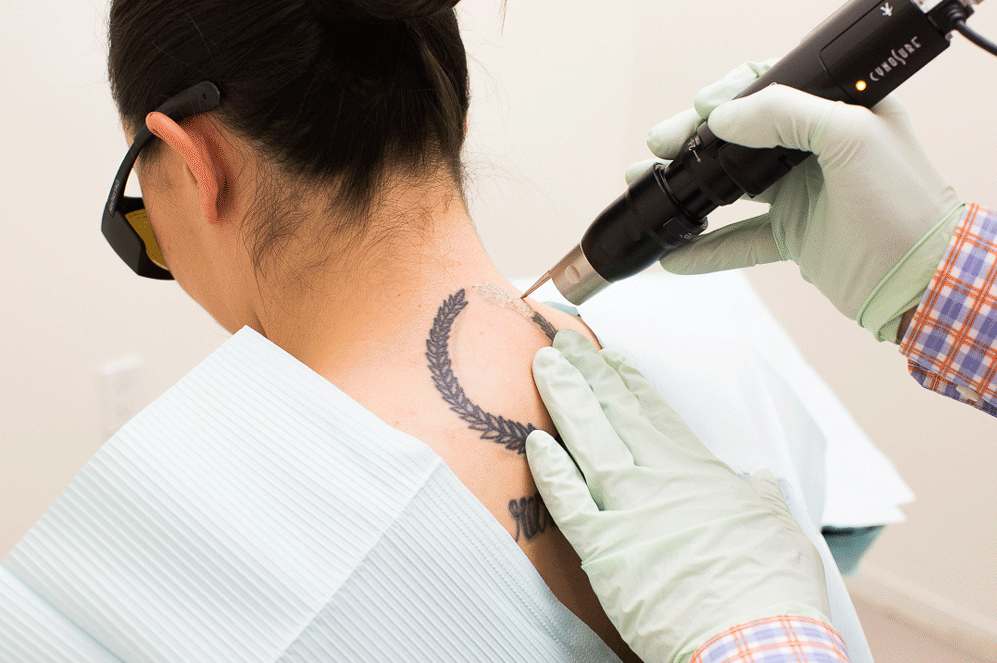
Are you the not-so-proud owner of some regrettable ink and considering tattoo removal? Welcome to the club. I have four (five, if you count the one on my back as two) tattoos from my late teens and early twenties that I could probably definitely do without. So I set out to finally part ways.
If you’ve heard anything about laser tattoo removal, it’s probably along the lines of it being insanely painful, like maybe even more than getting the tattoo in the first place. But while there’s plenty of info on what to consider before getting a tattoo (and pages on pages of enticing inspo), there still isn’t a whole lot of discussion surrounding the dark side of ink jobs: What happens if you grow to no longer love that little shooting star or random Latin phrase (ahem, see below)?
While going through the process, I picked up a handful of tips along the way that I wish I’d known going into it. So to do you all a solid, I put together a list of everything I’ve learned. From the costs associated to the potential side effects, here’s what you need to know about tattoo removal.
1. Consider a doctor or a tattoo removal specialist.
I’d previously had one tattoo zapped at a spa (I was living in small-town Canada where there weren’t plastic surgery offices or dermatologists), where an aesthetician used an outdated heat laser that ended up burning and scarring my skin. This time around, I got my treatments done by John F. Adams, M.D., at the New York Dermatology Group, where everything is done under medical supervision. I suggest you find your own removal expert by asking friends, influencers, or even by stopping people that you see with removal in process—which, yes, I have done.
2. It will take months—if not a year or more.
Tattoos don’t just disappear after a once-over with the laser. (I wish!) “A complete tattoo removal takes a minimum of 2 1/2 years on average,” says Bethany Cirlin, tattoo removal specialist and owner of Clean Canvas More Art. “Laser treatments should be scheduled three months apart from one another so you get the most out of each treatment. This allows your body to break down as much of the tattoo as it can while also giving your body the opportunity to heal completely before your next session.”
As of writing this, I’ve had six sessions, and I’d wager that I need about five more, despite the fact that my initial estimate was six to eight sessions. It takes a long time to complete because each time the tattoo is lasered, particles are broken down and digested by the body’s immune system. The regeneration period is up to eight weeks, and the next time you go, the laser breaks down new particles of pigment. And so on and so forth.
3. It’s expensive.
If you have your procedures done by a doctor, the bill for each visit can run you hundreds of dollars. Brace yourself: The American Society for Aesthetic Plastic Surgery estimates the average cost per session at $463. But see point number one for why it’s worth it. Your tattoo removal cost can also will vary based on the size, color, and age of your tattoo.
4. Familiarize yourself with the process before getting in the chair.
Just like any other major procedure, invasive or not, you should probably do a quick Google search as to how your treatment actually works. In a nutshell, the laser tattoo removal process is simple: the high-intensity light beam targets ink particles at different layers in your skin to be absorbed and broken down by your body, according to WebMD.
5. All ink can be taken out.
Contrary to the old belief that light, colored ink was hard to remove, Adams assured me that all hues will now disappear—no matter your skin tone. (FYI: The previous explanation was that, similar to laser hair removal, the laser would solely be attracted toward dark colors, like black.) With PicoSure technology, he says you can even get out yellows and greens, which were previously the most stubborn.
6. Lather up on the sunscreen prior to your sessions.
“Once you know you’re unhappy with a tattoo on your body, immediately start using a zinc oxide sunscreen on it,” says Cirlin. “The most common reason people can’t get lasered is because their tattoo has had sun exposure. By using a zinc oxide anytime you’re outside, you’ll help protect your tattoo, which will allow you to get lasered regardless of the season.”
7. Make sure to block out your schedule.
While some laser sessions are quick and easy, not all are. Mine have been taking about 45 minutes because we take before photos, clean the areas, inject them with lidocaine for freezing, laser them, ice them, and then bandage them. Oh, and sometimes a weird side effect happens where I taste metal when the laser hits my skin. Adams says it’s a sensation that some people experience when the lidocaine is hit by the laser and that it’s totally normal.
8. There might be some pain during the session.
But consider this warning from Cirlin first: “Pain is completely individualized, and if you tell someone that something is going to hurt, they go into it with that expectation. That said at my practice, we offer a topical numbing cream, which helps to take the edge off the procedure.” Just know that even with a numbing cream though, your experience may not be totally pain-free. “We also use a piece of equipment called a chiller that uses cold air to help keep our clients comfortable,” she says. It’s definitely worth asking for a consultation with your practitioner ahead of time if you’re worried about pain.
9. There might be some slight discomfort after your tattoo removal procedure too.
I would advise you budget for discomfort for about a week. For me, the sites blister and need to be covered in a salve and bandaged for a few days; then they start to depuff, scab, peel, and regenerate. There is good news though: The more treatments you have, the less after care there is (since there’s less ink reacting to the laser).
10. Prepare for your tattoo aftercare in advance.
You’ll need things like Aquaphor, bandages, and even clothes that don’t rest on your tattoo. Yes, I actually bought shirts that didn’t have material where my neck/back tattoo is. At first, I was cutting clothing tags out, but when tagless cotton tees still made the spot hurt and itch, I figured keyhole backs were a good investment. If you have tattoos on your ribs or feet (and like to wear bras and shoes) it might be best to plan your sessions accordingly.



